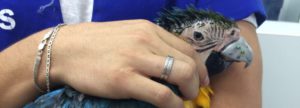For the first time ever, a prosthetic titanium beak has been manufactured using 3D metal printing and implanted on Gigi, a blue macaw (a genus of the parrot family), in Brazil. This unusual prosthetic saved Gigi’s very life, as macaws are unable to eat solid foods without a beak.
 The illegal trade of wild birds is a sad story of greed, and it doesn’t just happen in Brazil. The victims are magnificent creatures whose very beauty can end up being their downfall. During Gigi’s captivity at the hands of illegal bird traders, poor housing conditions caused severe malformation of the bird’s beak. Ultimately, Gigi was freed by the Brazilian police, but the magnificent bright blue and yellow feathered macaw could no longer be fed without a beak. A team of veterinarians, together with 3D printing experts from the Renato Archer Technology and Information Center (CTI) in Campinas, Brazil, developed an implant solution for the bird. The successful operation took place on February 18, 2016 at the Animal Care Center in Ipiranga near Sao Paulo.
The illegal trade of wild birds is a sad story of greed, and it doesn’t just happen in Brazil. The victims are magnificent creatures whose very beauty can end up being their downfall. During Gigi’s captivity at the hands of illegal bird traders, poor housing conditions caused severe malformation of the bird’s beak. Ultimately, Gigi was freed by the Brazilian police, but the magnificent bright blue and yellow feathered macaw could no longer be fed without a beak. A team of veterinarians, together with 3D printing experts from the Renato Archer Technology and Information Center (CTI) in Campinas, Brazil, developed an implant solution for the bird. The successful operation took place on February 18, 2016 at the Animal Care Center in Ipiranga near Sao Paulo.
An interdisciplinary team effort
The artificial beak was created thanks to the cooperation of three specialists. The team, dubbed the “Avengers,” was comprised of veterinarian Roberto Fecchio, 3D designer and facial-reconstruction specialist Cicero Moraes and veterinary dentist Paul Miamoto. The “Avengers” are pioneers in the use of 3D printing technology for saving the life of wild animals, having previously made a new shell for Freddy the turtle and a beak for an injured toucan. These prosthetics were made of plastic. In the case of Gigi, Plastic was not suitable. Macaws use their beaks to open seeds and break other hard shells, meaning that their beaks need to be extremely long-lasting and strong. This being the case, the team decided on the extremely hard material titanium. Titanium presented itself as the perfect solution, as it is biocompatible, lightweight and corrosion-resistant. Many prosthetics for people are produced using titanium today, so why not try using the material to help a wild bird?
First LaserCUSING, then a successful operation
Paul Miamoto began by taking a series of photographs of the malformed beak. From these, Cicero Moraes created a digital 3D model for the perfectly fitting prosthetic. The beak was then laser melted at the Renato Archer Technology and Information Center (CTI). Gigi’s artificial beak was created using a Mlab csuing R from Concept Laser, with which especially delicate parts with high surface quality can be manuf actured. The smallest system model from Lichtenfels proved to be the right choice for saving Gigi’s life. The operation then took place at the Animal Care Center in Sao Paulo. Veterinarians Roberto Fecchio, Sergio Camargo, Rodrigo Rabello and Methus Rabello participated. The 3D-printed prosthetic was secured in place with bone cement and orthopedic screws. Just 48 hours after the operation, Gigi was able to try out the beak. She made a fantastic recovery at the Center for Research and Screening of Wild Animals (CEPTAS) at Unimonte University. Gigi is currently awaiting placement at a zoo, where visitors can marvel at the bird’s one-of-a-kind beak secured in place with colorful rhinestone-styled screws. The other birds are going to be seriously jealous.
actured. The smallest system model from Lichtenfels proved to be the right choice for saving Gigi’s life. The operation then took place at the Animal Care Center in Sao Paulo. Veterinarians Roberto Fecchio, Sergio Camargo, Rodrigo Rabello and Methus Rabello participated. The 3D-printed prosthetic was secured in place with bone cement and orthopedic screws. Just 48 hours after the operation, Gigi was able to try out the beak. She made a fantastic recovery at the Center for Research and Screening of Wild Animals (CEPTAS) at Unimonte University. Gigi is currently awaiting placement at a zoo, where visitors can marvel at the bird’s one-of-a-kind beak secured in place with colorful rhinestone-styled screws. The other birds are going to be seriously jealous.
Bottom line
All’s well that ends well. Examples like Gigi show that 3D-printed medical technology isn’t just capable of providing greater quality of life to people. The unlimited geometric freedom of the process enables the manufacture of perfectly fitting implants ideally suitable for each respective application. Ultimately, it was able to help a magnificent wild bird overcome injuries and deformities, so there is good news in our often uncertain and sometimes unsettling world.



